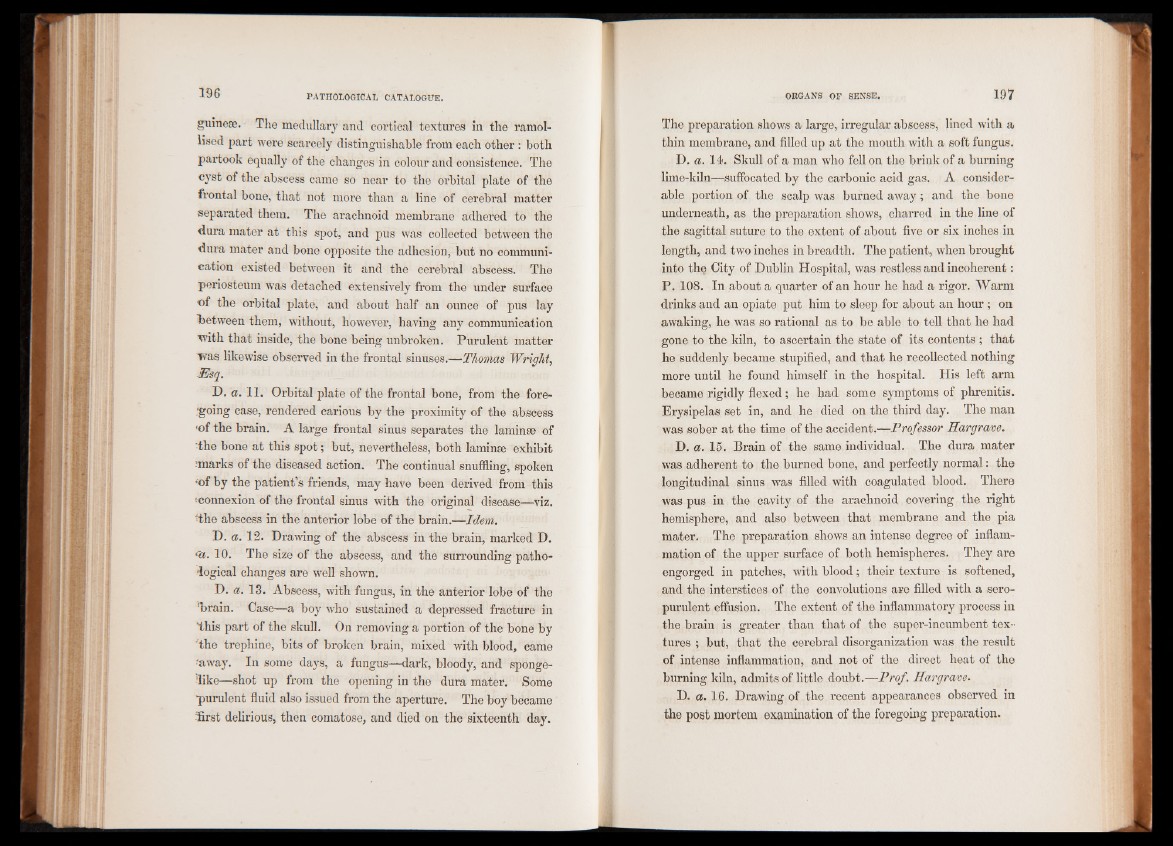
guinese. The medullary and cortical textures in the ramol-
lised part were scarcely distinguishable from each other : both
partook equally of the changes in colour and consistence. The
cyst of the abscess came so near to the orbital plate of the
frontal bone, that not more than a line of cerebral matter
separated them. The arachnoid membrane adhered to the
dura mater at this spot, and pus was collected between the
dura mater and bone opposite the adhesion, but no communication
existed between it and the cerebral abscess. The
periosteum was detached extensively from the under surface
■ of the orbital plate, and about half an ounce of pus lay
between them, without, however, having any communication
xvith that inside, the bone being unbroken. Purulent matter
■ was likewise observed in the frontal sinuses.—Thomas Wright,
dEJsq.
D. a. 1 1 . Orbital plate of the frontal bone, from the foregoing
case, rendered carious by the proximity of the abscess
'of the brain. A large frontal sinus separates the laminae of
the bone at this spot; but, nevertheless, both laminse "exhibit
-marks of the diseased action. The continual snuffling, spoken
■ of by the patient’s friends, may have been derived from this
'connexion of the frontal sinus with the original disease—viz.
tthe abscess in the anterior lobe of the brain.—Idem.
D. a. 1 2 . Drawing of the abscess in the brain, marked D.
ca. 10. The size of the abscess, and the surrounding pathological
changes are well shown.
D. a. 13. Abscess, with fungus, in the anterior lobe of the
'brain. Case—a boy who sustained a depressed fracture in
this part of the skull. On removing a portion of the bone by
the trephine, bits of broken brain, mixed with blood, came
■ away. In some days, a fungus—dark, bloody, and sponge-
dike—shot up from the opening in the dura mater. Some
■ purulent fluid also issued from the aperture. The boy became
fflrst delirious, then comatose, and died on the sixteenth day.
The preparation shows a large, irregular abscess, lined with a
thin membrane, and filled up at the mouth with a soft fungus.
D. a. 14. Skull of a man who fell on the brink of a burning
lime-kiln—suffocated by the carbonic acid gas. A considerable
portion of the scalp was burned away; and the bone
underneath, as the preparation shows, charred in the line of
the sagittal suture to the extent of about five or six inches in
length, and two inches in breadth. The patient, when brought
into the City of Dublin Hospital, was restless and incoherent:
P. 108. In about a quarter of an hour he had a rigor. Warm
drinks and an opiate put him to sleep for about an hour; on
awaking, he was so rational as to be able to tell that he had
gone to the kiln, to ascertain the state of its contents ; that
he suddenly became stupified, and that he recollected nothing
more until he found himself in the hospital. His left arm
became rigidly flexed; he had some symptoms of phrenitis.
Erysipelas set in, and he died on the third day. The man
was sober at the time of the accident.—Professor Hargrave.
D. a. 15. Brain of the same individual. The dura mater
was adherent to the burned bone, and perfectly normal: the
longitudinal sinus was filled with coagulated blood. There
was pus in the cavity of the arachnoid covering the right
hemisphere, and also between that membrane and the pia
mater. The preparation shows an intense degree of inflammation
of the upper surface of both hemispheres. They are
engorged in patches, with blood; their texture is softened,
and the interstices of the convolutions are filled with a sero-
purulent effusion. The extent of the inflammatory process in
the brain is greater than that of the super-incumbent textures
; but, that the cerebral disorganization was the result
of intense inflammation, and not of the direct heat of the
burning kiln, admits of little doubt.—Prof. Hargrave.
D. a. 16. Drawing of the recent appearances observed in
tiie post mortem examination of the foregoing preparation.